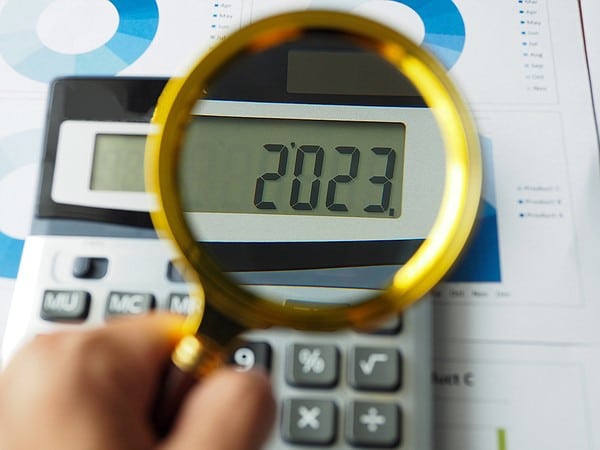Most forecasters would rather forget about 2022. Rarely have so many forecasters been so wrong about handicapping the year just ended, which should remind us not to rely too heavily on short-term forecasts to build portfolios. long-term investment.
Yet, what would the New Year be like without a fearless preview of the attractions to come? With a good dose of humility, that’s it.
— Inflation. With few exceptions, most economists have missed this one. A surge in demand combined with supply chain disruptions caused inflation to rise in 2021, but most experts, including the Federal Reserve, expected the price disruptions to be ” transitory”. Instead, 2022 turned out to be even hotter. The Philadelphia Fed’s survey of professional forecasters predicted CPI inflation to average 2.7% in 2022. The actual figure is closer to 7.7% and its stubbornness required a radical change in Fed policy.
Expect inflation to decline throughout 2023, but not reach the Fed’s 2% target by the end of the year, ending around 3% to 4% d here December. As durable goods and energy prices moderate, some components of the CPI like rents, services and wages tend to be “sticky” and will take longer to tame.
— Interest rate. Once the Fed recognized the persistence of inflation, it acted aggressively, raising benchmark interest rates by 0.25% to 4.5% between March and December, the largest percentage increase in a single year ever recorded. Additionally, the central bank allowed its massive balance sheet to shrink as the bonds in its portfolio matured, further tightening monetary conditions.
However, the work is not finished. Interest rates remain below the Fed’s preferred measure of inflation, implying that real rates are still negative. Rates will need to rise above the rate of inflation and stay higher for a considerable period, suggesting further hikes in February and March, then stabilizing for the rest of the year. As markets fell victim to bouts of wishful thinking, the Fed has consistently asserted its determination not to repeat the mistakes that led to the stagflation of the 1970s.
— Recession. Given the well-documented stubbornness of inflation, the Fed’s actions are expected to drag the United States into a recession by mid-2023. Interestingly, if that happened, it would be the most widely anticipated downturn in history.
Chances are that the recession will be relatively mild, as the conditions are absent for a severe shock like the insolvency of the banking system that led to the 2006 financial crisis. In fact, the recession could turn out to be so mild that GDP remains stable or declines only slightly for the whole of 2023 while unemployment climbs to 4.5%-5%. Overall, households still have savings in the bank, but rising credit card balances and retail finance rates will retard consumer spending, which accounts for two-thirds of the economy.
— Sotck exchange. Wall Street analysts prefer not to discuss their market expectations for 2022, for good reason. People who predict stock prices play an important role in society: making meteorologists look prescient. Goldman Sachs, for example, predicted that the S&P 500 would gain 10% in 2022, a far cry from the double-digit losses eventually incurred. In their defense, the base case was one of lower interest rates and transitory inflation which could have supported more robust returns but did not materialize.
Predicting the level of stock prices would be equally futile in 2023, but there are some headwinds. Rising interest rates and slowing demand will weigh on corporate earnings estimates, which may already be overly optimistic. This would increase downward pressure on equities in the new year.
The best news is that the stock market typically bottoms out before a recession ends and some of the fastest gains occur when sentiment is at its most pessimistic. If indeed the economy emerges from recession by the end of the year, stocks may have already sniffed out the nascent recovery and begun to forecast better growth for 2024. The bottom line for investors is that this opportunity will arise.
–Bitcoin. Seriously?
(Disclaimer: The above should not be taken as a recommendation to buy or sell any security. Consult your investment advisor before investing in Dutch tulip bulbs, cabbage patch dolls or any cryptocurrency ).
— Policy. Perhaps the biggest risk for the coming year is not inflation or the stock market but Congress. While both houses passed an omnibus spending bill last week avoiding a government shutdown, some members are already rehearsing for the biennial Theater of the Absurd featuring the debt ceiling. An archaic holdover from World War I, Congress must periodically raise the statutory debt ceiling allowing the US Treasury to raise funds that Congress has already spent. Failure to do so would precipitate a catastrophic default, but in recent years some members have exploited this threat to extort attention from their own priorities. Such a tightrope strategy has already cost the United States its once pristine AAA credit rating. Another episode could exacerbate a mild recession into a hard landing and potentially erode the dollar’s preferential status. This horror show is expected to open around September. Hoping it gets bad reviews and closes early.
Some of these broad themes can help investors rebalance their portfolios or underweight certain sectors. But it bears repeating that while forecasts are a fun New Year’s tradition, they’re still wrong, and the key to long-term investing success is maintaining consistency and discipline in the face of uncertain times.
Christopher A. Hopkins is a Chartered Financial Analyst and co-founder of Apogee Wealth Partners.
